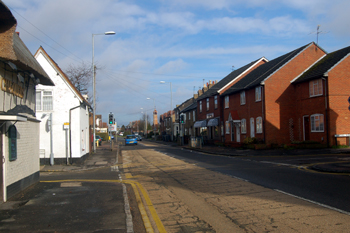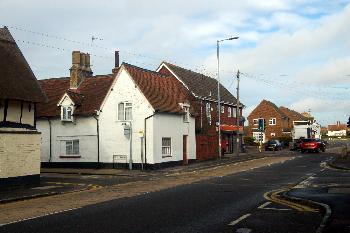Westoning Tanker Explosion
![The remains of the tanker and the devastation [FSD/RR143]](/CommunityHistories/Westoning/WestoningImages/The remains of the tanker and the devastation [FSD.jpg)
The remains of the tanker and the devastation [FSD/RR143]
Westoning became national news on Saturday 11th September 1976 when a petrol tanker overturned and then exploded in the High Street. Bedfordshire Fire Service attended the scene and afterwards sent in a Research Report to the Home Office as it was an unusual occurrence. The edited report is as follows [FSD/RR143]
![The east side of the High Street in 1972 [Z50/130/19]](/CommunityHistories/Westoning/WestoningImages/The east side of the High Street in 1972 [Z50-130-.jpg)
The east side of the High Street in 1972 [Z50/130/19]
Summary of Incident
A call was received at Bedfordshire Fire Service Control, Kempston, at 0715 hours, the caller saying "Something has blown up in Westoning High Street - the whole street is alight". The officer in charge of the first appliance en route to the incident, when two miles away, saw a large pall of smoke and flames rising from the centre of the village and sent an assistance message for additional fire appliances and men.
On arrival, he was confronted with a serious fire situation of a petroleum spirit tanker which had overturned blocking the road and burning fiercely. He described what he saw as a "fire ball". Houses and shops on both sides of the village street were also involved in fire. Persons were reported as being missing from some of these premises and a search procedure for casualties was immediately put into hand by firemen wearing breathing apparatus. At 0749 hours the Chief Fire Officer arrived and took command. Extinction was achieved by the use of high expansion foam onto the tanker and six water jets on the premises involved. A water carrier was sent on to supplement water supplies.
The "fire surrounded" message was sent at 0826 hours.
Petroleum spirit vapour had entered utility service ducts and the surface water draining system. This was ignited and minor explosions lifted a number of inspection covers in the locality.
Public utility services were quickly on the scene and assisted in locating the run of drains and cable ducts which Fire Service personnel, assisted by a petroleum officer from the County Consumer Protection department, continuously monitored for any petroleum spirit vapours with combustible gas detectors, until the initial danger was passed. Further checks were carried out for a period of 36 hours. Over 100 persons were temporarily evacuated from their homes in view of this risk.
The unsafe condition of the fire-damaged buildings made the search for casualties most hazardous and it was not until 1022 hours when the "stop message" was sent that it could be safely assumed that all persons who were known to be in the vicinity at the time of the incident were accounted for.
In the circumstances it was fortunate that the driver escaped from the vehicle and was not incapacitated and was able to give details of the tanker's load immediately to Police and Fire Service. The tanker was loaded with 22,000 litres of petroleum spirit carried in 7 compartments. Due to weight restrictions on the tanker, three of these compartments were only partially loaded and one was empty. When the tanker overturned the rear compartment was fractured, allowing the petroleum spirit to leak on to the roadway. Within seconds the vapour was ignited. The resultant fierce fire heated up the empty and partially loaded compartments, causing an explosion within a few minutes. The whole of the load was consumed in the fire, which destroyed 80% of the aluminium shell of the carrying tank. Ten properties, including three main shops of the village were involved; six were severely damaged by fire and 21 persons made homeless.
A rest centre was set up in the village school and the homeless, and persons temporarily evacuated, found shelter until alternative arrangements could be made. Apart from the driver of the tanker, who was slightly injured, no other casualties resulted. A fire appliance en route to the fire overturned and two firemen received injuries which necessitated hospital treatment and a subsequent period off duty.
The last fire appliance left the scene of the incident at 1115 hours on Sunday the 12th of September
![The west side of the High Street in 1972 [Z50/130/24]](/CommunityHistories/Westoning/WestoningImages/The west side of the High Street in 1972 [Z50-130-.jpg)
The west side of the High Street in 1972 [Z50/130/24]
Point of Origin of Fire
From witnesses it would appear that the overturned vehicle stopped before the flames were seen to come from the tanker. The officer in charge of the first appliance in attendance reported that the tanker was seriously involved in a fire, which was spreading to buildings on each side of the road.
![The High Street looking north-east with the Chequers in the left foreground about 1900 [Z50/130/9]](/CommunityHistories/Westoning/WestoningImages/The High Street looking north-east with the Cheque.jpg)
The High Street looking north-east with the Chequers in the left foreground about 1900 [Z50/130/9]
Buildings
1 High Street, private house, two storey, brick walls, timber floors, tiled roof approximately 12 metres by 14 metres.
5 High Street, retail grocers, sub post office and private house, two storey, brick walls, floors part timber, part concrete, roof part slate, part timber and asphalt, approximately 14 metres by 14 metres.
4, 6 and 8 High Street, private terraced houses, two storey, brick walls, timber floors, slated roof, approximately 13 metres by 9 metres.
10 High Street, butcher's shop and private house, two storey, brick walls, floors part timber, part concrete, slated roof approximately 10 metres by 14 metres.
12, 14 and 16 High Street, terraced private houses, two floors, brick walls, timber floors, slated roof, approximately 10 metres by 10 metres.
2 Park Street, retail bakers and private house, two storey, brick walls, timber floors, slated roof, approximately 11 metres by 24 metres.

The east side of the High Street January 2010
Supposed Cause of the Fire
It is apparent that the vehicle turned to its right (off) side and slid approximately 20 metres in that position. Heavy scoring of the shell of the end section of the carrying tanks resulted from contact with the road surface. The end compartment (number 7) was fractured and allowed petroleum spirit to be released. This is confirmed by a witness's account of petrol being sprayed on to the front of a house. Another witness, who was travelling in his car towards the tanker, reported that the tanker stopped before the flames were seen. This is confirmed by the fact that the driver had time to climb out of his cab before the vapour was ignited. Having established that the probable origin of the fire was the tanker, then the supposed cause is assumed to be: - heating of component parts of the tanker caused by friction between the overturned tanker and roadway igniting petroleum spirit vapour.

The west side of the High Street in January 2010
General Description of the Damage
- Vehicle. The tractor remained relatively intact, but was extensively damaged by fire. The semi-trailer was severely damaged by fire, approximately 80% of the aluminium shell of the tank being burned away. 22,000 litres of petroleum spirit was destroyed by fire.
- 1 High Street: 50% of first floor, 50% of walls, 50% of the roof severely damaged by fire. 50% of the contents severely damaged by fire.
- 5 High Street: 50% of first floor, 50% of walls, 50% of the roof severely damaged by fire.
- 10 High Street: 50% of first floor, 20% of walls severely damaged by fire. Roof completely collapsed. All contents of house, 50% contents of shop severely damaged by fire.
- 4, 6 and 8 High Street: first floor severely damaged by fire. Roof destroyed by fire. Contents severely damaged by fire.
- 12 High Street: Timber garden fence and timber door severely damaged by fire.
- 14 and 16 High Street. Timber garden fence severely damaged by fire.
- 2 Park Road. 4 window frames and door severely damaged by fire. 50% of the roof damaged. 25% of contents of ground floor shop damaged by water.
- 2 telegraph poles and 2 street lighting points attached thereto damaged by radiated heat.
![Plan of the overturned tanker [FSD/RR143]](/CommunityHistories/Westoning/WestoningImages/Plan of the overturned tanker [FSD-RR143].jpg)
Plan of the overturned tanker [FSD/RR143]
In the sketch plan above Bernard Deacon's the butchers is shown in blue, the post office in red and the Chequers in yellow.